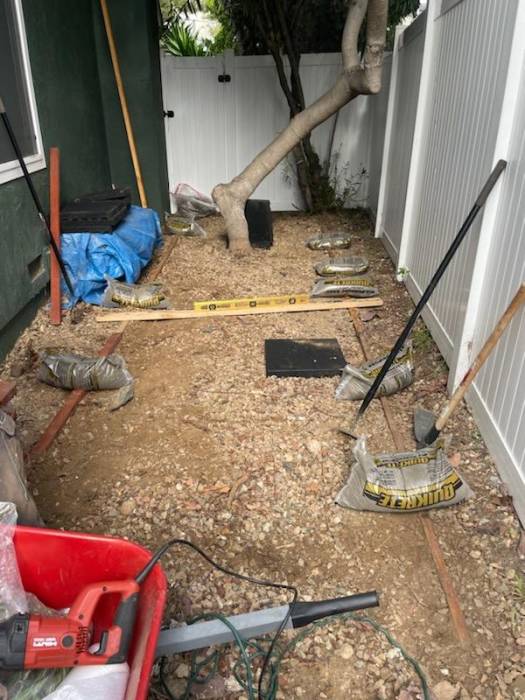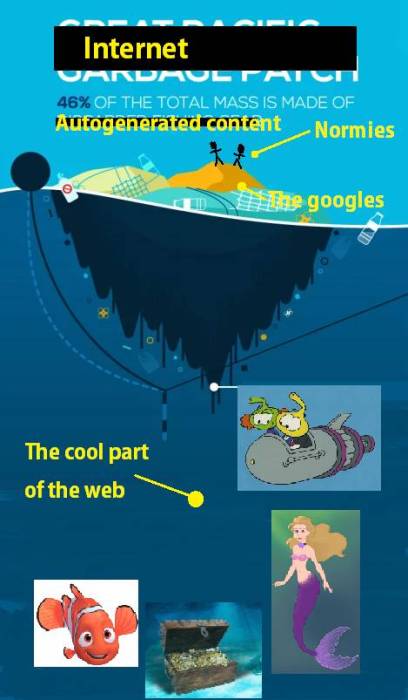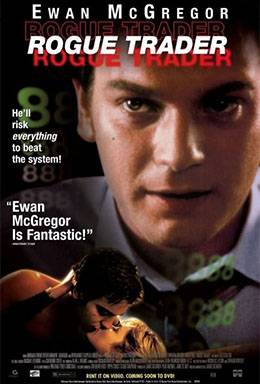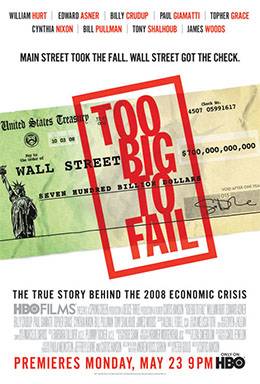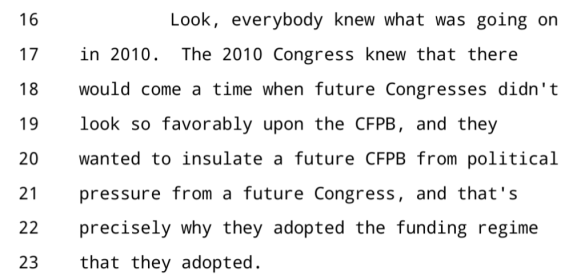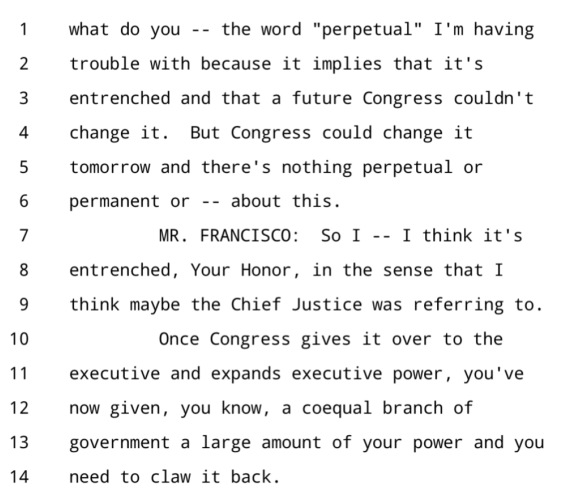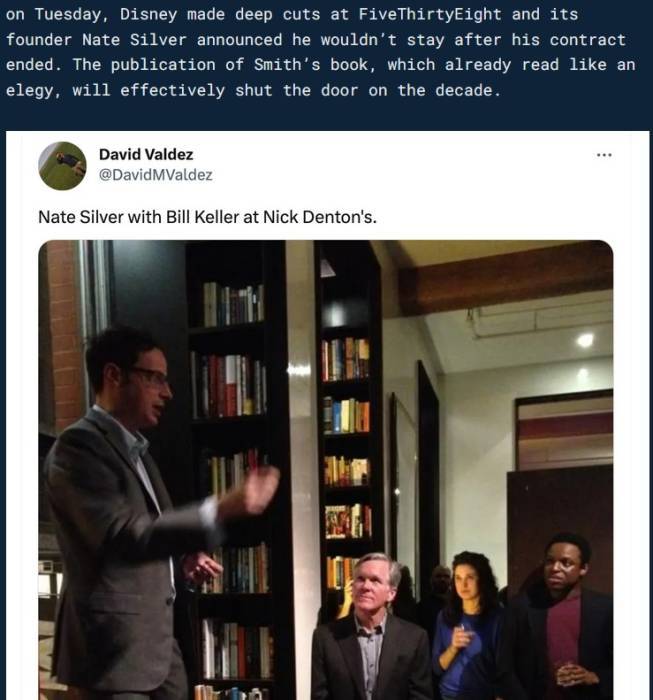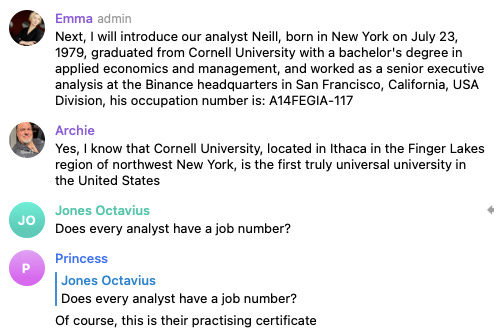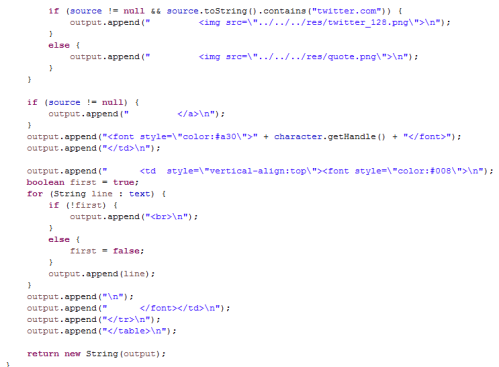|
|
|
Welp, she's figuring out dual stick controllers with a little help from Sloth. |
My Thanksgiving project was to create
an 18'x5' play area (with rubberized flooring) in the heretofore-unused sideyard. And there are a few odds and ends at the bottom of this post.
Sideyard play area
Jes and I
have been moving from surface to surface in the yard, replacing everything that was previously filled with pointy rocks and/or junipers. Some areas had
a v2 in the past 15 years, but now I'm older, wiser, and better able to afford renovations.
This brings us to the east sideyard whose critical features are the following:
- Small
- Trapezoidal
- Prolific avocado tree
- New fence
Jes is always eyeing a new play area though we kicked around the idea of a dog run or dromedary pen. I briefly considered installing a slide but we settled on a more age-independent feature since
Dani would probably be past sliding age by the time I finished. The winning proposal was
a small, rubberized play area where the little one can hop/tricycle (now), jumprope (soon), and do yoga or whatever (later).
Step 1: prep and order
Both of the big box hardware stores ship (not stock)
rubberized playground/gym tiles that lay on any flat ground.
Napkin measurements indicated that we needed 32 tiles: 11 x 3 - 1. The manufacturer makes ramp thresholds but the Q&A said those are optional and mostly for creating a raised surface on, say, concrete. Also, in line with the laws of flooring economics, the ramps are considerably more expensive. This didn't matter to us though,
we needed a barrier threshold to keep the landscaping out of the playspace and the kid vomit out of the landscaping. For this we ordered rubberized gardening curbs which are made of very much the same shredded tires stuck together with adhesive.
Step 2: level
The installation info said that the ground should be flat and level.
I sank a couple of 2x2 guides into the ground with ample buffer to my expected tile surface dimensions.
The ground in the sideyard is rocky - good for drainage and firmness, bad for flatness. After a few passes with my flattening 2x4, I added
concreting sand.
My retired turf cleats are in the work shoe rotation, it turns out
the studs are a great way to see what was under level.
Lastly I applied
landscaping fabric to keep the sand and tile separated.
Step 3: tile
The tiles lay next to each other and connect with plastic pins.
The pins don't prevent the tiles from floating away from each other so it became apparent I'd need a firm boundary. The landscaping felt is kind of a pain to slide the tiles on since it wants to bunch up in the gaps. These things are probably a lot easier to install on concrete.
The tiling part went pretty quickly. Though my subsurface isn't perfectly flat, I did notice cases of Cybertruck-esque manufacturing tolerance in the tiles (which is somewhat understandable since they are just rubber smashed together).
Step 4: boundary curb
The 2.5" tall tiles towered above the 1.5" landscaping curbs but it was okay because (as previously mentioned) I needed something to squeeze the tiles together. I considered pouring concrete but it'd be way too thin and staking the curbs would become a problem. Fence planks were the perfect height, but wood on the ground is a nonstarter.
Aha! I had some synthetic deck boards salvaged from
an earlier project that I had since disassembled. Using strong tie connectors, the boards framed the tiles nicely.
The synthetic frame gave the rubber curbs their needed height boost and a solid foundation to send their stakes through.
By far
the most annoying thing was cutting the curbs to 45-degree corners. I guess the intended application is just bendy sections and the "cuts easy with a sawzall" faq refers to the notched sections. My miter saw did it but it was not great. The rubber melts and smokes and flies everywhere and I probably need to buy a new blade. EcoBorder, please, sell corner connectors.
Step 5: 'mire
Ignore the bricks, they're pinching the adhesive-joined corners together. Next weekend I'll cover the fringe with more landscaping felt, then at some point we'll bring in wheelbarrows of
large stones to surround the jumprope/soccer/kumite area.
Other renovation stuff
|
|
|
The light angle makes this look rather dreary. |
And now for another installment in
the saga of making wood resistant to sun, rain, and termites: the linseed oil bath.
Part I: shou sugi ban,
Part II: linseed oil soak. There was some room to improve on the soak - it requires doing everything in a weekend and my setup was rather leaky. With a 10' rain gutter and a lot of time, I've been able to give the boards a lengthy opportunity to sponge up the oil and hopefully become distasteful to termites.
Here are boards from the before pile and the after pile, each having sat for at least a couple of weeks. The wet look is encouraging however it probably means the board will quickly collect particulates from the air and end up looking rather dirty.
Etc.
The
GBES crew excursioned to
Guadalupe Brewery. The brews were good and the taco tent was amazing.
Thanksgiving is about turkey, family, and lively political discussion. On the heels of another federal budget continuing resolution and headed into a presidential election year, this should be a Thanksgiving for the ages.
Dry run
I was recently reading the
comments section of
a WSB post about BofA predicting $50B in distressed debt and saw this flamebait:
 Euro347 Euro347 |
we send Ukraine $100B a month. Should be fine.
|
A robust discussion followed:

|
/u/TheManWhoClicks
Most of the money has been spent already. ATACAMs for example are at the end of their shelf life, some being produced in 1996. It's not that there are palettes with dollar bills being flown over. The equipment gets purchased from US companies so the cash stays in circulation here. But all of this doesn't sound that enraging so let's keep your understanding.
|
|

|
/u/impulsikk
So now we get to spend another 200 billion to make new ones that we will send to X war 20 years from now and say "don't worry that stuff was made 20 years ago and money was already spent". "We need to rebuild our weapons that we depleted sending to Ukraine."
|
|
|

|
/u/TheManWhoClicks
As far as I know ATACAMs are a thing of the past and that program ended, replaced with something else. And again, end of shelf life means you have to make new ones and spend the money anyways if you want to keep that system alive. And yes, you are correct, if in 20 years we have a war X and those newly produced things start to deteriorate, then the cycle repeats. I am not a huge fan of spending so much taxpayer money on military gear, I am just pointing out how things are. But no matter what, in my book the old ATACAMs are being put to great use over there. I don't want Putin being able to expand his wannabe empire. Nothing within his borders does well.
|
|
|
|
|

|
/u/TheManWhoClicks
For sure, from the view of the US this is the most economical way of depleting Russia's military assets and curb its influence.
|
|
|
|

|
/u/surmoiFireNever
ATACAMs are being replaced by Precision Strike Missile. 2 missiles for the same pod. [1]
|
|
|
|

|
/u/impulsikk
So.. "end of shelf life", but also fully capable of defending against Russia. Which one is it?
|
|
|
|
|

|
/u/iPigman
It speaks volumes about the superiority of our equipment and the inferiority of Russia.
|
|
|
|
|
|

|
/u/impulsikk
It speaks volumes people actually believe fully capable weapons are "phased out" rather than Raytheon and Lockheed Martin just want a new contract to make new stuff. [2]
|
|
|
|
|

|
/u/Splurch
> So.. "end of shelf life", but also fully capable of defending against Russia. Which one is it?
Both, not sure why you think it's an either/or situation.
|
|
|
|
|
|

|
/u/impulsikk
If we trust that they are effective enough for ukraine to defend against russia, then why do they need to be phased out? Is the "shelf life" they determined fake or artificial? [3]
|
|
|
|
|
|
|

|
/u/Splurch
Because things don't last forever in storage and it costs money to maintain them, the longer they stay in storage the more it costs to maintain them (more parts fail, less parts are available because the production lines were stopped decades ago) and as technology advances the less useful they are against a peer adversary. Ukraine also isn't fighting current gen tech and much of the equipment we're sending Ukraine, despite being old, was literally designed to fight the hardware Russia is currently using.
|
|
|
|
|
|

|
/u/impulsikk
According to.... lobbyists paid by Raytheon or bureacrats that want to pad their budget and will switch jobs to some military contractor after 5 years?
I dont believe their bullshit. Same people that put us into trillions of dollars of debt to fight some goat herders in the desert.
|
|
|
|
|
|
|

|
/u/TheManWhoClicks
Can you elaborate your claim? Who got paid by whom, how much, when and exactly why? Or are you just spitting out simple queues of words that appear to make sense? Deterioration of rocket propellants are a real thing as well as end of life for seeker heads.
|
|

|
/u/SpamSink88
"oh don't worry the cash stayed here with Lockheed and raytheon"
How does that make it ok? At least the cash going to Ukraine would've negated some inflation, cash staying here just adds to inflation. Best would've been just not to spend. Screw Ukraine and screw Lockheed. If they govt has got some extra money then just refund the taxpayers. [4]
|

|
/u/hermanhermanherman
Yes we should give the banks 46 billion in surplus military assets to help them out.
Average WS bets level of understanding of what's going on lol [5]
|
Say what you will about degenerate gamblers, I think they're doing a better job than the House of Representatives or your average podcast.
I annotated a few comments to add some clarification/commentary:
- From my reading, the PSM isn't yet deployable so ATACMS has a few years left. That said, unless we preemptively station them in Taiwan or invade Iran, they're probably going to be gathering dust.
- /u/impulsikk's comment is too reductive to really address but I'd be remiss to not point out that 'Options & Maintenance' dollars are absolutely a priority in the defense-industrial base. Sure the Lockheeds and Raytheons love to sell the next technological leap but those processes are more risky and laborious than O&M wins.
- To /u/impulsikk's credit, at least he sticks around the discussion and asks honest(?) follow-ups.
- Refunding military contract money to taxpayers would be inflationary as well so it's probably best not to take that narrow view, especially with something that has profound global security implications.
- Referencing the media's concern trolling about supporting Ukraine when Maui was devastated by wildfires.
|
|
Source. Russia's expectation for a three-day war, exactly as it occured in the timeline where Harambe is still alive. |
To the dinner table
Last winter the Ukraine conflict exited its period of dominating the news cycle. The war was no longer new, there weren't as many human rights atrocities, and it became clear that neither side was looking at a near-term military victory. So aside from the occasional cruise missile strike on infrastructure, suicide drones in Moscow, and
PMC mutiny,
it was easy to lose track of Ukraine's fight for independence.
But then the US House of Representatives got involved. If Ukraine aid is something the president and upper house can agree on, surely it's a reason to boot Kevin McCarthy from speakership and go four-plus months without a budget. And so the conflict became a lot harder to ignore because it ground Washington to a halt.
I'll hit the highlights of the rhetoric that flies around the media, previewed in the WSB discussion above.
"The summer offensive failed"
Between the very modest gains of Russia's 2022/2023 winter offensive and Ukraine's summer offensive,
not a lot of territory has changed hands. The how and why are way out of my depth, but I'll regurgitate some things I've read:
- The inability of either side to gain air superiority (due to good antiaircraft systems) has made it mutually difficult to advance.
- Poor Russian logistics combined with effective Ukrainian anti-armor hobbled the Russian offensives.
- Extensive Russian minefields backed by artillery support has deterred Ukrainian advances.
- Grenade/suicide drones have proven an effective as defensive weapons.
And so from a territorial perspective,
the summer offensive certainly did not push Russia back to its borders. But that might be largely irrelevant when you consider what winning looks like...
"Ukraine is losing"/"Russia is winning"
When people talk about the stalled summer offensive, I wonder what they envision the endgame to be. Is it like Risk where you fight all the opposing pieces in a territory and either succeed or halt your attack and gain nothing?
I'm not sure pushing Russia back to its pre-war borders brings the conflict any closer to a conclusion. Considering Moscow's "NATO expansion" rhetoric and its inability to not invoke the Great Patriotic War, perhaps this would only strengthen their resolve. Since Ukraine isn't going to capture Moscow or depose Putin,
their path to victory is to defeat Russia's will to continue the war.
Ukraine is doing an admirable job of eroding that will by inflicting heavy casualties on the invading force. The rest of the western world, except Rand Paul, is doing an admirable job of
eroding that will by isolating Russia economically. Are we near the end? As they say, the end will be gradual at first and then sudden. But its portentous to see more waves of mobilization, the Russian central bank doing emergency rate hikes, pro-invasion milbloggers getting locked up, and the MoD hitting up North Korea for munitions.
So yeah, Ukraine pushing Russia back to its 2014 borders would be neat and useful in ceasefire negotiations. But those negotiations won't happen until Russia no longer wants to fight.
"... so why back the losing side?"
Here's one: Russia has
threatened nuclear escalation at numerous points in this conflict. They're not even fighting us, just our scrapyard-bound equipment. You'd think Russia, of all countries, would have a kinder view of lend-lease but I'd settle for threats that were in the same ballpark of reciprocity.
There are other reasons of course, another being that they already said, "you're not on our side".
"Blank check..."
Rand Paul and the Freedom Caucus are quick to
describe the Ukraine aid packages as palettes of cash being shipped to Kyiv. Well, they largely let their proxies use the words 'cash' and 'blank check' while they stick to more accurate/ambiguous terms such as 'funding'. Somehow the waters are muddy enough that someone in Washington had to call it out as malarky:
 President Biden
President Biden |
We send Ukraine equipment sitting in our stockpiles. And when we use the money allocated by Congress, we use it to replenish our own stores, our own stockpiles, with new equipment. Equipment that defends America and is made in America. Patriot missiles for air defense batteries, made in Arizona. Artillery shells manufactured in 12 states across the country, in Pennsylvania, Ohio, Texas. And so much more.
|
And he wasn't alone:
 Senator McConnell
Senator McConnell |
If you look at the Ukraine assistance, let's - let's talk about where the money is really going. A significant portion of it's being spent in the United States in 38 different states, replacing the weapons that we sent to Ukraine with more modern weapons. So we're rebuilding our industrial base."
"No Americans are getting killed in Ukraine. We're rebuilding our industrial base. The Ukrainians are destroying the army of one of our biggest rivals. I have a hard time finding anything wrong with that. I think it's wonderful that they're defending themselves.
|
The shout-outs are gross stump speech pandering but the numbers are available:
|
|
Source. From a pretty good PBS article that lists all of the Desert Storm-era materiel shipped to Ukraine as well the per-country aid chart but adjusted for GDP. |
"2017-2021: no invasion, 2021-2025: invasion"
I have a feeling we're going to hear a lot about this in the near future. Before I get into the validity of the claim, I should say I'm unsatisfied with the response commonly heard from the Left: "It's because when Trump was president, Putin got everything he wanted." This can't be true since we know that Putin wanted Ukraine. He also didn't want Ukraine to receive the blessings of St. Javelin, but that did happen. The claim is not meritless, of course, but it would benefit from some nuance.
So did Trump keep Russia out of Ukraine?
Viktor Yanukovych was Ukraine's president from 2010-2014, during this time Russia did not invade Crimea. Five days after Oleksandr Turchynov replaced Yanukovych, Russia invaded and Crimea. Could Yanukovych campaign under the banner of being tough on national security because Russia didn't invade in his term? Of course not, he fled to Russia to escape prosecution (and, well,
all this).
Or, simply, if the former president did keep Russia out of Ukraine it requires something more substantive than a tweet about a counterfactual.
 ISW
ISW |
Russian President Vladimir Putin didn't invade Ukraine in 2022 because he feared NATO. He invaded because he believed that NATO was weak, that his efforts to regain control of Ukraine by other means had failed, and that installing a pro-Russian government in Kyiv would be safe and easy. His aim was not to defend Russia against some non-existent threat but rather to expand Russia's power, eradicate Ukraine's statehood, and destroy NATO, goals he still pursues.
|
United States v. Zackey Rahimi
A couple of weeks ago I got sucked into
oral arguments for the payday loan lobby's attempt to destroy the Consumer Financial Protection Bureau. I noticed we're finally getting a follow up to
last year's Bruen ruling wherein Justice Thomas called for a comprehensive reevaluation of firearms regulation. This year we'll see multiple 2A cases but
US v. Rahimi went first.
The tldr
There is a federal law that basically says
someone under a protective order for domestic violence faces inprisonment for not surrendering their firearms.
Bruen's
originalism test calls this law into question because, well, there weren't any instances of domestic abusers having their firearms taken away in our country's founding era. And that's what the lower court ruled to land this case in front of Roberts et al.
There's some discretion in the 'histories and traditions' test; the
Bruen decision says that a modern law doesn't need an 'exact twin' from 1789. So the
Rahimi decision will be the
first major guidepost for interpreting the 2022 ruling.
Not exactly a poster boy

|
JUSTICE THOMAS: And we are -- we have a very thin record, and I'm trying to get a sense of what actually happened in this case.
MR. WRIGHT: So there are allegations that were taken in the federal pre-sentence report, and -- and those are the ones that made their way into the opinion below. And if I could then distinguish between the facts that the court found for purposes of fixing a sentence in this case and the facts that could be contested at a jury, the facts that are the subject of the guilty plea, the ones that are essential to the conviction, in terms of the former category, there was a finding that there was, you know, a physical assault, that someone had attempted to intervene and that Mr. Rahimi had fired a gun into the air at that time. Those -- and -- and -- and there are pending charges right now in Tarrant County for three misdemeanor offenses that are the same allegations that are the -- so -- so the -- the federal pre-sentence report found that those actions preceded and were the cause for the protective order.
|
Huh. Well we're talking about constitutional rights here so the specifics don't really matter. At a high level, the USG had
two potential approaches to defend the constitutionality of Congress's disarmament law:
- Assert that the provision fits within the totally acceptable framework of Bruen, lending the originalism test legitimacy in order to win the day.
- Try to contest or evade the originalism element of Bruen.
The first option was the USG's position because it kind of had to be. Interestingly, Justice Jackson seems to have adopted the second one and argued it throughout the proceeding.
Elevator pitches
Solicitor General Prelogar, representing the United States:
the contested statute falls within the latitude afforded by Bruen in finding historical precedence, the authority to disarm citizens has analogues e.g. children and the mentally incapacitated.
 Solictor General Prelogar
Solictor General Prelogar |
Like Heller and McDonald, Bruen recognized that Congress may disarm those who are not law-abiding, responsible citizens. That principle is firmly grounded in the Second Amendment's history and tradition. Throughout our nation's history, legislatures have disarmed those who have committed serious criminal conduct or whose access to guns poses a danger, for example, loyalists, rebels, minors, individuals with mental illness, felons, and drug addicts.
|
J. Matthew Wright, representing Zackey Rahimi: simply
there were no founding era laws penalizing firearm possession from persons within the political body.
 J. Matthew Wright
J. Matthew Wright |
Justice Kagan, I'm looking for a ban [from the founding era to use as a Bruen analogue]. I'm looking for a ban, some criminal punishment for just the keeping of a firearm. That's what I'm looking for. And it's based not on the loss of status of citizenship, you know, or being outside the community. I'm looking for a ban that applies to a rights-holding American citizen. I mean, that's -- I'd start with that.
Short of that, again -- and I suspect the response to that is this Court has tentatively approved felon in possession. But felons are so different. They have all kinds of process. There's a long tradition of denying people convicted of infamous crimes all manner of rights of citizenship or not.
|
Facial challenge, due process challenge, and trying again next year

|
CHIEF JUSTICE ROBERTS: Well, but it -- it's a facial challenge.
MR. WRIGHT: Right.
CHIEF JUSTICE ROBERTS: And understand your answer to say that there will be circumstances where someone could be shown to be sufficiently dangerous that the firearm can be taken from him.
MR. WRIGHT: Yes.
CHIEF JUSTICE ROBERTS: And why isn't that the end of the case?
MR. WRIGHT: Because --
CHIEF JUSTICE ROBERTS: All you need to do is show that there are circumstances in which the statute can be constitutionally applied.
|
I wonder of Chief Justice Roberts is hoping to make this one go away quietly. After ethics scandals, politicization, and the near-abandoment of
stare decisis,
re-arming domestic abusers is probably the last thing he wants added to his legacy.
Justice Jackson v. originalism

|
JUSTICE JACKSON: Then what's the point of going to the Founding Era? I mean, I thought it was doing some work. But, if we're still applying modern sensibilities, I don't really understand the historical framing.
GENERAL PRELOGAR: The work that history and tradition are doing is helping to discern those principles in the first place. The idea, for example, that you can ban firearms in sensitive places, the fact is that the Framers didn't ban firearms in schools even though they existed at the Founding, but the Court has already recognized that those analogues and the historic banning of firearms in places where they present safety concerns can justify a modern-day regulation that does require the banning of weapons in schools.
|
Justice Jackson seemingly tried to bait the Solicitor General into condemning the originalism part of
Bruen. Prelogar's responses seemed to be, "you can fit a lot under the originalism umbrella, here is what the Court has already put there...". She also
asked the respondent if 'histories and traditions' makes sense as a general principle:

|
JUSTICE JACKSON: But we have a history and traditions test. I -- I guess I -- I'm a little troubled by having a history and traditions test that also requires some sort of culling of the history so that only certain people's history counts. So what do we do with that? Isn't that a flaw with respect to the test?
MR. WRIGHT: Your Honor, I think what you do is the Bruen test starts with the text. And so, ultimately, historical tradition as I understand it is something the Court does to make sure its textual interpretation is correct and consistent with the original understanding of the amendment.
So, in the situation that you're describing, those laws, they were not people who were part of the community. They never -- they weren't seen as the people. And when these laws were challenged, including in this very Court, that was the reason.
|
The architect

|
JUSTICE THOMAS: My -- my question -- the reason I'm asking you that, you made the point that that was a -- a small matter and it has huge consequences. I think you said that even if Respondent moved to another state or across the country, the consequences would be the same, even though he would present no danger in Texas.
And just to be clear, are you -- you're not challenging the state court aspect of this?
MR. WRIGHT: That's -- that's correct, Your Honor.
JUSTICE THOMAS: But solely -- and your language was it was a per se violation or automatic violation of 922, and that is your problem?
|
Justice Thomas appeared to
lay the foundation for an opinion that a federal-level disarmament is overkill, probably handwaving away stalkery behaviors and cities like Cincinnati and Memphis. Even more nonsensical is the idea that states could handle disarming domestic abusers in their own jurisdictions when the
Rahimi challenge is a constitutional one.
In fact, this makes so little sense that I'm almost certain this isn't what he's getting at.
The bigger picture
It's possible that the Court will try to make this one go away and not decide if there is historical precedent for disarming non-felons. As Prelogar points out (and everyone predicted last year),
Bruen declared open season on firearms legislation and
lower courts have interpreted the originalism test in a variety of ways:
 Solictor General Prelogar
Solictor General Prelogar |
I think that it's important for the Court to understand the destabilizing consequences of that reading in the lower courts.
Just last week, a court invalidated Section 922(g)(1), the felon prohibition statute, on its face as applied to the most violent and horrific crimes imaginable on the theory that the government didn't have a sufficiently precise historical analogue to justify a permanent ban on felons... And a court has also invalidated on its face the provision of federal law that prohibits possession of firearms with obliterated serial numbers, again, on the theory that we don't have a Founding Era analogue that is sufficiently precise that says you have to serialize firearms possession.
|
Now you're ready for Thanksgiving
Enjoy, just keep in mind that if you're done with dinner and still sitting at the table, talking politics, and swirling your third gravy martini, it might to time to punch out.
Can links pages and webrings save us from broken search and the dead internet?
Mystery box
Dani's school has a thing where each week a kid has to take home the 'mystery box' and
bring it back with an item corresponding to the letter of the week. They also bring three clues that the other kids use to guess the mystery item. Of course we got 'I', the dumbest letter of the alphabet.
We didn't happen to have any toy ice cream or insects laying around and the real deal probably wouldn't have been a good idea.
What other toddler-friendly I words are there. This is what the internet* is for, right?
* I-word but neither compact nor toddler-friendly.
 Osmo
Osmo |
List of I words for kids
The letter I is an important part of the alphabet. Several simple words that start with I form the foundation of the English language. Most sentences would be incomplete without words like I, it, is and in. These are words that we use every day while conversing. When your child is ready to learn I words, start with these basic words so that they understand and learn easily.
|
"The letter I is an important part of the alphabet." Ugh, this is clearly GPT-generated because who else would make qualitative claims about letters? And yet, I just need a word. If
RyanButBetter can create a LotR tierlist, surely this page has some candidates.
 Osmo
Osmo |
4 letter I words for kids that start with I
Into Item
Iron Isle
|
'Isle' is a bit out there, but not bad so far. 'Item' would not be a very good mystery box submission and an iron wouldn't fit.
 Osmo
Osmo |
5 letter I words for kids that start with I
Image Inlet
Input Inept
|
I do hope my kindergartener starts calling people 'inept' so by the time she gets to grade 1 she'll will be talking about 'income' and 'indigo'.
To round out the
SEO formula, the page has
the pleasantly-redundant "Tips to help your child learn I words for kids" which I found to be redundant but in a humorous way. And if tips aren't enough, "Frequently Asked Questions on I Words For Kids".
The dead internet and search indexing
Oh right, I ended up running to the toy store to get an ice cream stuffy.
This left me time to think about the dead internet theory - that everything on the internet is autogenerated (it predates GPT btw). It's hyperbole, of course, but as my graphic way at the top suggests, the alive internet is getting harder to find (particularly the night before you have to bring a mystery box to school).
I should be intellectually honest though,
"I-words for three-year-olds" should never be written by hand. This is absolutely the kind of thing an algorithm could, say, parse from kids books and categorize by part of speech. But GPT isn't that algorithm and trussing it with redundant sentences and FAQs isn't the presentation format.
Luckily I have a better example from this very week:
 OSO
OSO |
Troubleshooting F61 Error Code on Panasonic Devices
Are you having trouble with your Panasonic device and getting the F61 error code Look no further This blog post provides a DIY guide to troubleshoot and fix the issue quickly and easily
|
A quick troubleshoot and fix, count me in. The fix:
 OSO
OSO |
First, the power switch should be checked to ensure there is no disruption to the supply of power to the machine. If this is determined to not be the issue, it's important to have a qualified technician look at the machine and assess what the cause of the error is.
|
Thanks, autogenerated web content, your DIY quick fix is to call a repairman. Btw if you're distressed that these snippets lack 'FAQ' and 'Takeaways' sections, fear not, I pasted the whole thing to the bottom of this post.
I should have gone to YouTube for this but I hate YouTube. Unlike toddler I-words,
troubleshooting a piece of electronics is very much the kind of thing a handful of hobbyist sites could help with. It'd be nice if they weren't buried under meaningless, necrotic internet.
|
|
Source. Apparently Google once told users to shed pounds by eating glass. The 'False' bit wasn't saying that the screenshot is phony but that you, in fact, should not eat glass. |
 jrmg
jrmg |
I think that part of this is that small web sites simply are not being indexed by Google at all any more.
My ~15 year old blog has, according to Google Search Console, 15 indexed pages, and 174 'Discovered - currently not indexed' pages. The number of indexed pages is going down over time, despite occasional new posts.
The Search Console page says "Examine the issues [...] to decide whether you need to fix these URLs." But about the only suggestion I can find is just to wait for them to be indexed - which doesn't seem to ever happen.
I wouldn't argue my blog is the best or most exciting content in the world or anything, but I can't believe anyone would say it's worse than the often-incorrect SEO-informed duplicative nonsense that fills the first few pages of Google search results for anything technical nowadays.
|
In
a Hacker News discussion about blogging, I found some gripes that
had me saying, "same, girl, same".
 Amezarak
Amezarak |
Sites are actively being deindexed. My entire website, probably 20 years old now, used to be indexed. Now only a few pages are.
|
And I imagine the HN community is considerably better about indexer nitpicking (canonical links, ssl, etc.) than I am, so their experience should be closer to the mainstream. Moving on from the question of de-indexing longstanding content,
one commenter suggested that Google is having trouble keeping up:
 ushercakes
ushercakes |
It's not just you - this is widespread.
I run a SaaS to help site owners get their content indexed. We're seeing an influx of users, I think a lot of the issue is simply because of AI.
New web page additions were pretty linear over time, and then AI copywriting tools came out. Suddenly page additions basically went "hockey stick"/vertical.
Now, you can publish thousands of pages in a few minutes, and it's created a huge backlog in Googles crawl queue, thus increasing overall time to get indexation, disproportionally affecting smaller sites.
|
Lolll I wonder if this is true. From a technical perspective, it seems like you'd need to be strong in one or two of the following areas to not be buried in scrape backlog:
- Cloud, so you can scale to meet demand.
- Algorithms, so you can properly prioritize your queue.
- AI, so you have expertise with the influx of hallucinated content.
Google (and Microsoft, for that matter) are typically regarded as titans of all three domains. So either ushrecakes is inferring way too much from his clients' inability to get indexed or the search companies have failed to execute on their core competencies. Or, you know, they're okay letting search languish
because people are addicted to it.
|
|
Source. Google's original name, not sure why they selected an arm with 80th percentile hairiness. |
More HN commiseration:
 m-i-l
m-i-l |
Same here - most of my personal site has been stuck in Google's "Discovered - currently not indexed" limbo for nearly 2 years, despite regularly submitting pages for indexing, and doing all the usual things like optimising Lighthouse score and so on. I went on the Google Search support forums and it was quite sad - just vast numbers of people crying into the void. It is almost like Google have given up on search.
|
Meltdowns sound like a refreshing change from all the simping I found when I
encountered this issue. Be right back.
Back to the indieweb project
Google is failing m-i-l, Amezarak, and ushercakes's clients, to whom do they turn? Time for another installment of my
web 1.1 discussion.
Webrings
A mainstay of web1 has been making the rounds on Hacker News: web rings.
 Dragontamer
Dragontamer |
Have you actually used Webrings?
Lets say I click on a webring, and the "next" button goes to a 404 error. Now what? How do I access all the other links?
Answer: you can't. Its basically lost information. Webrings require ALL the web-administrators in the ring to keep their previous-and-next links up-to-date, otherwise the whole ring collapses.
There's a reason why we stopped doing Webrings when Geocities stopped being popular. I've lived Geocities -> Homestead -> Xenga -> Myspace -> Facebook. At no point did anyone ever care to go back to webrings.
And suddenly here we are like 20+ years later, where people who clearly never used them are suddenly pretending that it was webrings that made the early internet great. Erm, no. I guess they were a sign of the times... but they weren't good or great by any means. We have better means of sharing links with each other today.
|
It's been a long time since I clicked on a webring link. I guess they were ring-shaped so everyone got equal clicks? Certainly
the shape is a pretty clear risk when anyone at any time can go offline but I'm on board with the idea of linking peers based on topicality.
Marginalia search and link pages
 Marginalia
Marginalia |
Web rings are cute, but I think they are a bit too random to help. Likewise, curated link directories were a thing back when the Internet was in its infancy, but the task of maintaining such a directory is a full time job.
You could go for some sort of web-of-trust model to only allow trusted submitters access to an automatic link feed, but that practice is excluding and creates yet more walled gardens, which impairs the very discoverability I'm trying to help.
|
The indexing comments from above came from a Hacker News post linking Marginalia's 2021
"The Small Website Discoverability Crisis" post. The author makes the case for how
the internet will wither into a commercial hellscape if small websites remain invisible and unreachable.
 Marginalia
Marginalia |
A proposal, dear reader: Create a list of bookmarks linking to websites you find interesting, and publish it for the world to see. You decide what constitutes "interesting".
The model is as recursive as it is simple. There is nothing preventing a list of bookmarks from linking to another list of bookmarks.
|
The author
recommends emphasizing the 'links' section of websites, echoing an old web design paradigm. Federated page discovery worked well enough in the 90s. From the user standpoint, to
quote myself, "I can say with authority that small web discovery should resemble the wikihole user experience."
 StableAlkyne
StableAlkyne |
Links sections were awesome, and made the web feel deeper than it really was. You could go on dives just clicking through and finding so much cool stuff. Plus if it was a hobby site, there was inherently some level of curation - I don't think anybody would be linking to any of the hundreds of lookalike SEO "blogs" nowadays if it weren't for search engines allowing themselves to be gamed.
|
I like the idea of having a robust links section, except for three things:
- This idea has been around for a long time and was once fairly standard. Then search crowded it out. Then web2 crowded it out. Links pages interconnect the internet's subsurface but don't do much to address the visibility problem.
- In the olden days, we'd link our friends' sites and things we thought were cool. In the case of Rob's popular Honda 350 carb overhaul post, it's unlikely a visitor would want to see other stuff from his social circle. Imho, topic-level granularity is crucial to an effective link.
- Following the above bullet, it's considerably more convenient to offer topical links within a post. A standalone website section has to serve all of the relevant subjects and links from the rest of the site.
Web1 over 5G
Something obvious that I hadn't thought about:
back in the olden days we needed to sit at a computer to read the internet. Nowadays we have phones and fast internet everywhere, something the thefacebooks and tiktoks have leveraged to create attention vortices. The optimistic side of this coin is that smartphones unlocked our ability to ingest information in the in-between times - in the dentist's waiting room, in line at In-N-Out, or at your kid's dance recital. Web1 didn't have mobile browsing but other than home page music,
its content is perfect for spare-minutes browsing. I get that many will prefer infinite scrolling viral dances and watching a retired mma fighter talk advertise electric cars, but
plenty of us use that time to read about wood treatment techniques, Elden Ring easter eggs, and PMC mutinies.
Moment of zen
|
|
Source. Meaningless content printer goes 'brrr'. |
As promised, if your Panasonic soundsystem shows F61, the DIY fix is to call a technician.
 OSO
OSO |
Troubleshooting F61 Error Code on Panasonic Devices
Are you having trouble with your Panasonic device and getting the F61 error code Look no further This blog post provides a DIY guide to troubleshoot and fix the issue quickly and easily
Image of Panasonic device showing an F61 error code
Fixes for the 'F61' Error Code on Panasonic Devices
When using Panasonic devices, it's important to be aware of potential errors that may be encountered. The 'F61' error code is among the most common errors encountered by Panasonic device users, and it can cause a lot of frustration. Fortunately, this issue can often be resolved quickly with a few simple troubleshooting steps.
The 'F61' error code is representative of a problem with the heating element in the Panasonic device. There could be a lack of power to the device, a bad thermistor, or a faulty drive or relay board that is causing the error.
First, the power switch should be checked to ensure there is no disruption to the supply of power to the machine. If this is determined to not be the issue, it's important to have a qualified technician look at the machine and assess what the cause of the error is.
If the technician determines the error is being caused by a faulty thermistor, they may suggest replacing it. This is a relatively easy repair, and a replacement part can be found quickly and affordably.
If the technician finds that there is a faulty board in the machine causing the 'F61' error, they will recommend replacing it. Again, a quality replacement board can be obtained quickly, and should resolve the issue.
In some cases, the technician may also recommend replacing the motor assembly in the machine, which can be more costly. If this is the suggested repair, it's important to get a full quote from the technician and compare the possible repair job to the cost of replacing the machine.
In conclusion, troubleshooting the 'F61' error code on Panasonic Devices can be relatively straightforward. To ensure the issue is fully resolved, a qualified technician should review the machine and assess what the issue is. A properly diagnosed issue can then be addressed quickly and affordably with genuine quality and certified appliance parts. To make sure you're getting the right parts for your Panasonic device, check out our Appliance Parts Suppliers page today.
Troubleshooting the Panasonic 'F61' Error Code
Q1: What is the Panasonic 'F61' Error Code?
A1: The F61 Error Code is an indication that any of the components in the Panasonic device is overheating and needs to be checked.
Q2: What types of Panasonic devices can experience the 'F61' Error Code?
A2: The F61 Error Code can affect various types of Panasonic devices, such as home theatre systems, air conditioners, and TV or radio sets.
Q3: What could be causing the 'F61' Error Code on my Panasonic device?
A3: Possible reasons for the F61 Error Code include build up of dust or debris in the vents, blocked ventilation due to overcrowding, or a faulty internal component.
Q4: How can I fix the 'F61' Error Code on my Panasonic device?
A4: Before attempting any troubleshooting, unplug the device from the power source and ensure that the vents are free from dust or debris. If the problem persists, please contact the nearest Panasonic service center for further assistance.
Q5: Is it safe to continue using my Panasonic device with the 'F61' Error Code?
A5: No, it is not safe to continue using the device. The F61 Error Code indicates the possibility of overheating and possible fire hazard. Please turn off the power to the unit and contact the nearest Panasonic service center for further assistance.
Key Takeaways:
If a Panasonic device displays an error codde F61, it is likely an issue with the heating element in the device.
The cause of the error could be a lack of power to the machine, a bad thermistor, or a faulty drive or relay board.
Troubleshooting steps should begin by checking the power switch and ensuring there is no disruption to the power supply to the machine.
To ensure the issue is resolved, a qualified technician should assess what the cause of the error is, and can recommend replacing a faulty thermistor or board.
In some cases, the technician may recommend replacing the motor assembly, which can be more costly.
Related Posts
0x204 RDS Error How to Resolve It - Jan 1, 0001
14e Error Code Troubleshooting Guide - Jan 1, 0001
3 Way Fridge Repairs Christchurch - Jan 1, 0001
|
Zac and Erin hosted
Friendsgiving this year, San Francisco rolled out the blue skies.
We've grown lazier/more efficient over the years;
rather than prepare a turkey, we ordered one from Popeye's and heated it. It was not bad at all. The covid-purchase castle bounce was a big hit with the kids,
Zac's garage was a big hit with the dads.
|
|
Of course Kevin called out what the Waymo was doing play-by-play. Almost like he was... driving. |
Speaking of lazy,
the Bay Area crew is completely in love with robotaxis, both for the convenience and for the drama surrounding Cruise's meltdown. I used the opportunity to rant endlessly about how self-driving cars are a solution looking for a problem and that you simply can't (yet) code or train an algorithm to fully understand the context of a situation on the road. They were having none of it. The car didn't have to decide between running into a trolley with 20 people or swerving to run into a trolley with 10 people so the matter was left unsettled.
Board games
The board game crew
stumbled into a final chapter victory over stupid Xaxos in Aeon's End Legacy. Maelstrom obliterated us twice in a row and we chuckled as the lore just inserted "and then all your friends appeared and saved the day". It was worth playing but it won't be at the top of my list of legacy games. Say, I should make a ranked list of legacy games.
We're not quite ready for Frosthaven so
we're going to play a season of Heat: Pedal to the Metal. As a
motorsports enthusiast I certify that the game mechanics are pretty good and eager to see what asymmetry does to things.
A couple of months ago NPR had a preview of the then-upcoming
Supreme Court calendar. In a follow up to
Bruen and Dobbs the court is considering birth control pills, the legality of bump stocks (made infamous at that Las Vegas concert), and whether a restraining order for domestic violence is sufficient reason to impact their second amendment rights.
I'm not going to talk about those, other than to relay the NPR analyst's take on things.
NPR was inclined to believe that SCOTUS would uphold the domestic violence gun control statues as a matter of sanity. If so, it should be interesting to see how the majority opinion backs into reasoning that aligns with 1789-era law, per the court's new 2A doctrine.
 Wikipedia
Wikipedia |
United States v. Rahimi
Whether 18 U.S.C. 922(g)(8), which prohibits the possession of firearms by persons subject to domestic-violence restraining orders, violates the Second Amendment on its face.
|
Oral arguments for that one were today, but I've been busy with work and vball and fixing a sink. The other one:
 Wikipedia
Wikipedia |
Garland v. Cargill
Whether a bump stock device is a "machinegun" as defined in 26 U.S.C. 5845(b) because it is designed and intended for use in converting a rifle into a machinegun, i.e., into a weapon that fires "automatically more than one shot by a single function of the trigger."
|
Consumer Financial Protection Bureau v. Community Financial Services Association of America, Limited
 Wikipedia
Wikipedia |
Whether the court of appeals erred in holding that the statute providing funding to the Consumer Financial Protection Bureau, 12 U.S.C. 5497, violates the appropriations clause in Article I, Section 9 of the Constitution, and in vacating a regulation promulgated at a time when the Bureau was receiving such funding.
|
NPR's synopsis of this one was that the Consumer Financial Protection Bureau cracked down on rotating payday lending fees. The payday lender lobbying group sued and appealed until they eventually
got the fifth circuit to say that the CFPB and everything it has done is bogus because it's funded by Federal Reserve dues. The analyst noted that the case calls into the question the legality of a variety of institutions, such as the Federal Reserve, the FDIC, social security, and the US Mint because none are funded through appropriations.
Oral arguments for this one were last month, the transcript was a pretty good read.
Summary
 US Constitution
US Constitution |
No Money shall be drawn from the Treasury, but in Consequence of Appropriations made by Law; and a regular Statement and Account of the Receipts and Expenditures of all public Money shall be published from time to time.
|
The controversy centers on whether the above sentence empowers Congress to:
- Create an entity (here, the CFPB) and allow it to be funded by another entity (here, the Federal Reserve).
- Permit that entity to have a standing budget that is not beholden to Congress's annual appropriations soap opera.
- Allow that entity to set its own budget. In the case of the CFPB, its budget was capped at $600 million and it only used $400 million.
One additional factor is the
principle of nondelegation that claims
it is the duty of one branch of government to not give its power to another branch. Specifically, the CFPB declaring it needs $400 million to operate is potentially a transfer of budgeting authority from the legislature to the executive.
Petitioners
Solicitor General Elizabeth Prelogar advocated for the CFPB's funding mechanism, asserting that
the CFPB is no different from many other agencies/programs funded without appropriations. She was certain to point out that the Justice Department's theory on Article I Section 9 is that 'appropriations' is meant to describe public funding and not the budget appropriations process itself.
Alito asked for the closest analogue to the CFPB, Prelogar went with one present at the country's founding:
It's probably worth mentioning that in the decade-plus that the CFPB has been around, we've remained more or less a democracy.
Respondents
Speaking for the respondents, Noel Franscisco did his best to beat to death the phrase "separating the purse from the sword". He described the CFPB setting its own budget as two steps from tyranny because once you give the executive the purse, it's game over. He
continually referred to a scenario where a government agency received unlimited funding in perpetuity, only acknowledging the CFPB's capped budget and nonpermanence when challenged. E.g. from Justice Kavanaugh:
I'm not sure if "Congress gives it over" is meant to describe the the capped budgeting discretion afforded to the CFPB or
some hypothetical where Congress writes a law saying "whatever the president says is as good as legislated".
Certainly, the Supreme Court is the right forum to discuss the bigger picture, but connecting the CFPB to "literal tyranny" isn't straightforward. And if Congress did try to pass a law permanently giving appropriations power to the executive, I doubt SCOTUS would grudgingly approve based on the precedent set in Payday Loan Scams v. Dodd and Frank.
Under questioning from Justice Barrett, Francisco seems to have clarified the respondents' position:
- The CFPB should have some budgetary leeway because nobody is perfect.
- $200 million of wiggle room (described by one justice as a rounding error in the federal budget) is too much. So much so that it's no different from Congress relinquishing its power over the purse.
- If Congress had capped the CFPB's budget at $400 million or, presumably, if the CFPB had spent its allotted $600 million, everything would be peachy.
Like,
how obvious is it that the respondents just want SCOTUS to kick the CFPB back to Congress for a budget cap tweak, knowing that the legislature is so broken it'll never happen.
|
Infopost | 2023.11.05
|
|
 |
 |
I've come across
three interesting posts from elsewhere on the
indieweb, their titles (links to follow):
- "What happened to blogging for the hell of it?"
- "Why You Should Write Your Own Static Site Generator"
- "A blog post is a very long and complex search query to find fascinating people and make them route interesting stuff to your inbox"
And for a little variety, two arts and entertainment posts:
- "Buzzfeed, Gawker, and the end of the 2010s"
- "My life in the Telegram Bitcoin scam group chat of ghosts"
There's
a recurring theme of static site generators (SSGs), so I'll start with talking about my own.
Graphics on an SSG
Putting a photo or screenshot or gif on a webpage is easy. Doing more than one can get a little tricky - it's not really a technical challenge (unless you make it one) but more a matter of how to use real estate. Here's a brief history of my SSG's graphics widgets.
It started with a polyptych.
Triptychs are common art presentation styles that can show juxtapositions or - more relevant to me - sequences of frames (though they are almost always cascaded horizontally). Adding these to my early SSG amounted to a width check and placing the images in a table.
Then came the
gallery of thumbnails. Centering and cropping the full images could have been accomplished in javascript and/or aggressive html/css but that's not my thing. Graphics are my thing, so with a little raster work I added the ability to create arbitrary-sized thumbnails for use in gallery widgets.
The initial thumbnailing implementation looked at contrast to automatically hone in on areas of interest. This worked well most of the time but a couple corner cases dicatated that I either use an off-the-shelf algorithm or, what I settled on, use
a simple click + mousewheel to specify thumbnail dimensions when generating a new post. I probably have enough data to train a half-decent machine learning model to do this automatically.
Since the center of a thumbnail is probably the highest area of interest in an image, that center value can be used to crop the shot to a non-thumbnail size. And so
horizontal polyptychs that stretch to the page width became a thing.
New widget
Triptychs are sometimes dictated by the content - e.g. three sequential frames of
Shane on and off his board tells the story. Alternatively, cascaded images is a nice way to show downscaled previews that might or might not interest a reader. Since I'm occasionally a UI guy, I broke it down into
the following use cases:
- "I want to see full res photos of everything on this subject because it interests me and I don't want to open new tabs to see full res." An example would be if there was a gallery of my nephew at a pumpkin patch - I'm in it for all the photos, just show them to me. For this I have the '[+]' slideshow view next to each month (it should probably also be available for each post).
- "I'm reading, but not sold on a subject, maybe something will catch my eye." E.g. I'm reading a post about bonds but the author also has some adorable dog pics, I might click through or I might want to keep reading about investing. Having an unintrustive graphics widget that highlights the best of the content is how I'd accomplish this.
- Finally, "I want to see photos on this subject, but let me see all of them with minimal scrolling". E.g. I'm looking for Halloween costume ideas, the thumbnails aren't detailed enough but the full size images don't have as much information density as something cropped and scaled.

There was some greatest common multiple work to get a clean right edge but it wasn't as painful as getting the tiling working in the thumbnail gallery. The rows alternate even/odd so the channels should never line up. Each row can have 2-5 images, favoring 3 and 4 but with a composition that's randomly created through (quick) brute force. And the images can be sequential or randomized.
More good reads
Back in September
I mentioned a couple of entertaining posts from a blog called Read Max. Or Max Read. Or whatever. Well here are two more good posts and then a bonus one from someone who decided web publishing might be fun.
"Buzzfeed, Gawker, and the end of the 2010s"
 Max Read
Max Read |
Buzzfeed and Gawker will be remembered in future movies and TV shows and novels as more than anything as symbols of a more-or-less lost decade, a privacy-flouting, social media-friendly ten years.
|
You know I'm something of a
20-teens cultural commentator myself. This post gave me those 2010s nostalgia feels -
Buzzfeed was the punching bag of internet culture and the Gawker network (mostly io9, Kotaku, Jalopnik, and Consumerist) was a great place for almost-news. To its credit, I guess Buzzfeed briefly had a Pulitzer-winning journalism shop.
 Max Read
Max Read |
But the decade really kicked into gear around 2012, when Facebook, apparently motivated by jealousy over Twitter's popularity among journalists (and specifically the extent to which they were crediting Twitter with the Arab revolutions of 2011), opened up a fire hose of traffic to anyone willing to make their headlines sound like they'd been written by a dog, but a dog who'd been genetically/cybernetically manipulated to have the intelligence of a seventh grader, but was subsequently brain damaged in a lab accident, and was also on coke.
|
"My life in the Telegram Bitcoin scam group chat of ghosts"
Another two things I like:
investing and
scammers getting theirs. I also have some affection for Telegram because
NCD often relays vatnik cope from Telegram channels. So I was naturally enthralled by Max's
synopsis of being invited to a scam investor group.
"What happened to blogging for the hell of it?"
 Whiona
Whiona |
I consulted my friend Startpage.com with the obvious prompt: "blog post ideas."
What I got was a roaring cascade of capitalist buzzword swill:
- 120 profitable blog niche ideas and how to pick the right one (Write what'll make you money!)
- 50+ blog post ideas to drive traffic and increase followers (Get those numbers UP, baby!)
- 60 blog post ideas to fill your content calendar (Gotta push out that ~content~ often enough for the algorithm!)
|
Oh man, this reminded me of
Dr. Jigsaw's SEO tips.
 Whiona
Whiona |
I'm probably saying nothing new to anybody who's been on the blogging scene for some time, but as a newcomer who's just here to write creatively and have fun, it was a stark reminder of how corporate the web has become.
...
I'm sick of everything having to be a hustle now, even something personal like sharing our ramblings with strangers on the internet.
|
Say what you will about being old, it's refreshing to not know anyone who has a hustle or claims to be a sigma anything. On the subject of cynicism, I got to Whiona's post by way of
Hacker News where the comment section was naturally full of snark, blog links, and Kagi
smallweb mentions.
 Whiona
Whiona |
I really want to write about Baldur's Gate 3, how it compares to Bioware titles, and how my personal feelings on said titles have changed over the years-but it would be pretty silly to do so before I've finished Baldur's Gate 3. I'm 100+ hours in now and just barely got inside the city walls!
|
Smallweb, SSG, POSSE, etc.
"What happened to blogging for the hell of it" is a good segue into
some more interesting discussions from HN.
"Why You Should Write Your Own Static Site Generator"
 Arne Bahlo
Arne Bahlo |
[Friends talking about upgrading Next.js] made me think about the longevity and robustness of my website and so I decided I don't want to depend on other people's decisions and run after version upgrades I don't care about.
And even if your content is Markdown and media, almost everything around it needs to be updated when switching frameworks-sometimes even when upgrading.
|
Writing a bunch of web publishing code simply to avoid a deprecation rugpull isn't the most convincing of arguments but having hated the transition from
Blogger and
Flickr, I'm on board. It's worth mentioning that those very simple platforms aren't nearly as expansive as the Substacks and Wordpresses.
 Arne Bahlo
Arne Bahlo |
After contemplating to build something dynamic2 for search without JavaScript, I decided to stay with a static site. It's faster and you don't have to worry about security or stability. And of course I choose the best programming language on the planet, Rust (my beloved). Wait, come back, this is not a Rust post!
A static site generator mostly needs to do five things:
- Convert markdown to HTML
- Render HTML templates
- Compile CSS
- Generate RSS feeds
- Generate a sitemap
And of these you might not even need the last three. Surely your favourite programming language has a Markdown parser and a templating engine.
|
Arne's recipe makes writing an SSG seem simple and, in it's purest form, it really is that simple. I got by without rss or a sitemap for many years.
Ingesting text and producing html can be solved with a nice, reliable, static library. But if it wasn't obvious from my widget polishing at the top of this post, I prefer a fully-featured SSG.
I wasn't enamoured with some of
the HN commentary.
 onli
onli |
Blogs are the worst use case for a ssg and you should focus on writing first. It's the articles that make or break a blog, and you might actually want the comforts of a dynamic blog engine. Plus comments, trackbacks and pingbacks, so it is a real blog.
Where static site generators shine are websites that are not blogs. Especially when generated from a data source. Then you can tailor your ssg to the data source, update the data and run the generator to update the site.
|
Certainly
content (not necessarily writing) is the most important aspect of web publishing but only the most time-constrained enthusiast needs to choose one over the other. And in the same way that any automation opens up one's availability to do other things,
automated site generation can liberate time for writing.
I really don't get that second paragraph about generating a site from a data source, that's exactly how my SSG works. The text files and images constitute a data source, the SSG publishes the content with a healthy dose of meta information and logic.
Then there were these comments:
 Linux-Fan
Linux-Fan |
I certainly learned to keep the featureset of such a program to a minimum in order to have a chance to "complete" and publish it.
|
 hombre_fatal
hombre_fatal |
It's a procrastination time hole that mostly just distracts us from the harder, less concrete, less fun thing we supposedly set out to do in the first place. It keeps us from shipping real shit.
e.g. Quit dicking around with your SSG and write the damn blog post already. The hard part of writing something worth reading is not your tech stack.
|
What is it with the Hacker News commenters and not being able to manage their time? Oh, okay that tracks. This talk of 'shipping' and grinding reminds me of Whiona's dissatisfaction with the influencer mentality of the web.
Regardless, hombre_fatal forgets about a little friend we call Sunk Cost Fallacy; if I spent my weeknights coding a new site feature I'm not going to subject myself to the regret of having spent that time on unused code. Also:
- The more optimistic version of that last point, if I have a neat new feature I'm more inclined to deploy it.
- The other other version of that last point, if I've automated something tedious like photo editing and cropping, I'm less likely to loathe finishing that backlogged post.
- More personally (but maybe not), while I enjoy software security work by day, it makes me really appreciate opportunities to code by night. Even if the feature is never used again, it's a thing I like to do.
But
the real value of a custom SSG? Features.
|
|
Source. Yes, an SEO post about if image alt text matters does feature a screenshot with stretched dimensions. |
It starts with
implementing the stuff any web publishing tool would have - photo editing/labeling, galleries, logs integration. When I
came across the Wordpress photo labeling tool a couple years ago, I was surprised by its similarity to my own.
But then when you realize you write about a lot of board games or video games,
they should be their own semantic thing on the site rather than a generic tag. Or
Erik asks, "hey remember that time we did that one thing, do you still have photos of that?" Or you realize you need a
dive log.
"A blog post is a very long and complex search query..."
... to find fascinating people and make them route interesting stuff to your inbox
 yCombLinks
yCombLinks |
The writing is pretentious, but the post has several interesting insights.
|
No kidding.
Moving on from SSGs, a few months back
I outlined how
tag/text/symantic matching between sub-corporate sites could be a great substitute for the lack of search engine support for quality user content. This 2022 blog post
linked from HN took the same concept in a slightly different direction:
 Henrik Karlsson
Henrik Karlsson |
The more precise and niche the words I input, the better the internet would match me with people I could forge meaningful relationships with.
|
My
first and
second iterations compared rss feeds to my site, in effect
finding blogs like mine. Henrik proposes using this method to find people like me.
From the comments section:
 celeritascelery
celeritascelery |
This makes me wonder if I should be writing on substack. I currently use a static site generator and host with netlify[1]. This is great because it is simple and I have complete control over the site. But at the same time I can't see when people visit my site and there is no comment section. I rely or external forums like HN, lobsters, and Reddit to have a discussion. And I have no way of knowing when my content gets shared because I can't see the traffic.
But my purpose of writing is the same as the authors, to find like minded people and have a discussion with them. It's kind of cure for intellectual loneliness.
[1] https://coredumped.dev/
|
I should say that traffic and referral information is available if your can get and parse logs from your host but there is a certain loneliness in the SSG life.
The big publishing platforms provide a lot of social network-esque features, ones that Henrik might use to find his tribe:
 Henrik Karlsson
Henrik Karlsson |
When writing in public, there is a common idea that you should make it accessible. This is a left over from mass media. Words addressed to a large and diverse set of people need to be simple and clear and free of jargon. It is valuable to write clearly of course, to a degree. Clear writing is clear thinking. But to make the content accessible? To cut digressions and obscure references to reduce the number of things people need to understand to make sense of your argument? Really?
That is against our purposes here. A blog post is a search query. You write to find your tribe; you write so they will know what kind of fascinating things they should route to your inbox. If you follow common wisdom, you will cut exactly the things that will help you find these people.
|
From the perspective of an indieweb discovery algorithm, peppering posts with jargon is a great way to identify similar content. But I would expect that for most, creating social circles is a secondary objective of web publishing.











